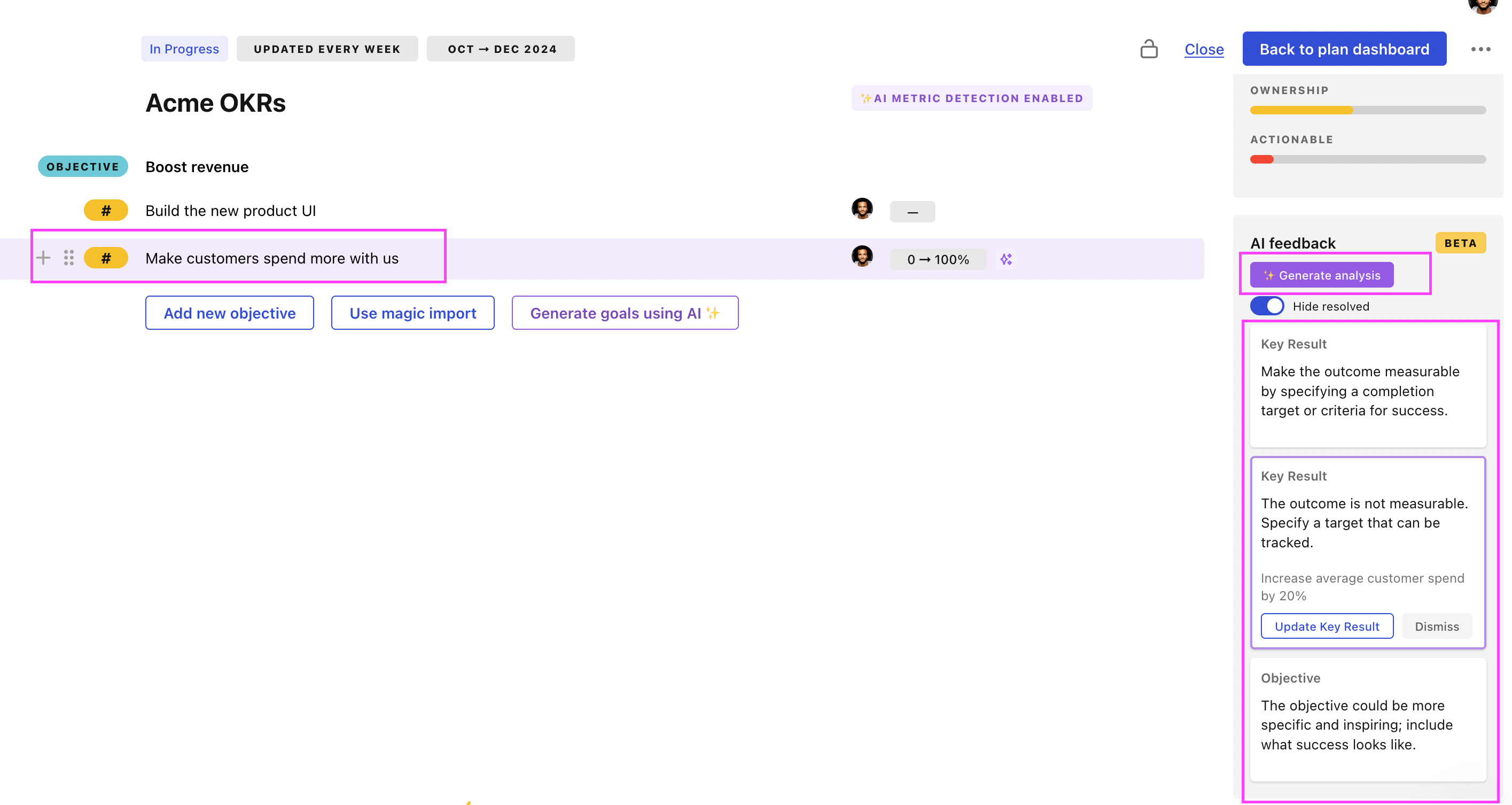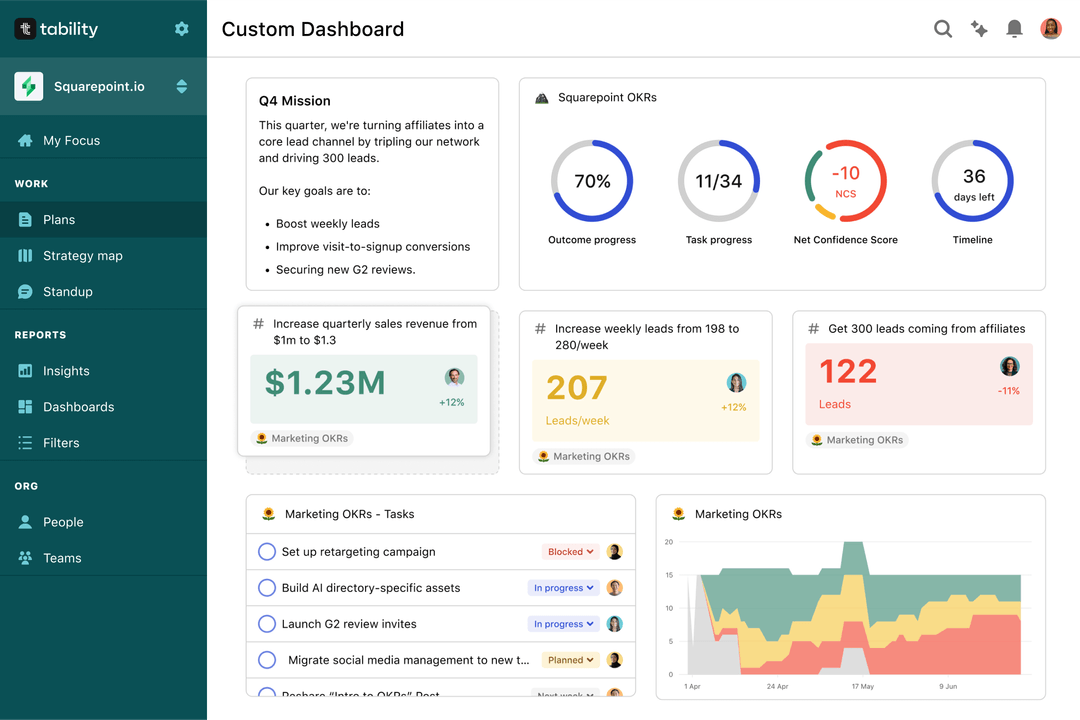Tability is a cheatcode for goal-driven teams. Set perfect OKRs with AI, stay focused on the work that matters.
What are Knowledge Transfer OKRs?
The Objective and Key Results (OKR) framework is a simple goal-setting methodology that was introduced at Intel by Andy Grove in the 70s. It became popular after John Doerr introduced it to Google in the 90s, and it's now used by teams of all sizes to set and track ambitious goals at scale.
OKRs are quickly gaining popularity as a goal-setting framework. But, it's not always easy to know how to write your goals, especially if it's your first time using OKRs.
To aid you in setting your goals, we have compiled a collection of OKR examples customized for Knowledge Transfer. Take a look at the templates below for inspiration and guidance.
If you want to learn more about the framework, you can read our OKR guide online.
The best tools for writing perfect Knowledge Transfer OKRs
Here are 2 tools that can help you draft your OKRs in no time.
Tability AI: to generate OKRs based on a prompt
Tability AI allows you to describe your goals in a prompt, and generate a fully editable OKR template in seconds.
- 1. Create a Tability account
- 2. Click on the Generate goals using AI
- 3. Describe your goals in a prompt
- 4. Get your fully editable OKR template
- 5. Publish to start tracking progress and get automated OKR dashboards
Watch the video below to see it in action 👇
Tability Feedback: to improve existing OKRs
You can use Tability's AI feedback to improve your OKRs if you already have existing goals.
- 1. Create your Tability account
- 2. Add your existing OKRs (you can import them from a spreadsheet)
- 3. Click on Generate analysis
- 4. Review the suggestions and decide to accept or dismiss them
- 5. Publish to start tracking progress and get automated OKR dashboards

Tability will scan your OKRs and offer different suggestions to improve them. This can range from a small rewrite of a statement to make it clearer to a complete rewrite of the entire OKR.
Knowledge Transfer OKRs examples
You'll find below a list of Objectives and Key Results templates for Knowledge Transfer. We also included strategic projects for each template to make it easier to understand the difference between key results and projects.
Hope you'll find this helpful!
OKRs to enhance resource management and knowledge transfer efficiency
ObjectiveEnhance resource management and knowledge transfer efficiency
KRIncrease resource allocation efficiency by 20% using improved management strategies
Implement advanced project management software for resource tracking
Establish regular resource usage reviews
Train team on efficient resource allocation methods
KRImplement two new knowledge transfer methods to improve team understanding
Research different knowledge transfer methods relevant to the team
Train team members in these new methods
Select two effective methods and plan their implementation
KRDecrease resource wastage by 15% through better forecasting and planning
Monitor and adjust resource usage regularly
Train staff on resource management and efficiency
Implement advanced forecasting tools for better planning
OKRs to enhance inter-team collaboration and knowledge transfer
ObjectiveEnhance inter-team collaboration and knowledge transfer
KRImplement weekly knowledge-sharing sessions with 90% employee attendance
Establish a consistent weekly schedule for knowledge-sharing sessions
Implement incentives for regular session attendance
Develop engaging session content relevant to all employees
KRIncrease utilization of collaboration tools by 40%
Share success stories involving tool utilization
Implement incentives for frequent tool usage
Conduct training sessions on efficient collaboration tool usage
KRAchieve at least 75% positive feedback on inter-team collaboration in next quarter's survey
Regularly acknowledge and reward successful team collaboration
Establish and enforce clear guidelines for respectful teamwork
Implement regular inter-team communication and collaboration workshops
Knowledge Transfer OKR best practices
Generally speaking, your objectives should be ambitious yet achievable, and your key results should be measurable and time-bound (using the SMART framework can be helpful). It is also recommended to list strategic initiatives under your key results, as it'll help you avoid the common mistake of listing projects in your KRs.
Here are a couple of best practices extracted from our OKR implementation guide 👇
Tip #1: Limit the number of key results
The #1 role of OKRs is to help you and your team focus on what really matters. Business-as-usual activities will still be happening, but you do not need to track your entire roadmap in the OKRs.
We recommend having 3-4 objectives, and 3-4 key results per objective. A platform like Tability can run audits on your data to help you identify the plans that have too many goals.
Tip #2: Commit to weekly OKR check-ins
Don't fall into the set-and-forget trap. It is important to adopt a weekly check-in process to get the full value of your OKRs and make your strategy agile – otherwise this is nothing more than a reporting exercise.
Being able to see trends for your key results will also keep yourself honest.
Tip #3: No more than 2 yellow statuses in a row
Yes, this is another tip for goal-tracking instead of goal-setting (but you'll get plenty of OKR examples above). But, once you have your goals defined, it will be your ability to keep the right sense of urgency that will make the difference.
As a rule of thumb, it's best to avoid having more than 2 yellow/at risk statuses in a row.
Make a call on the 3rd update. You should be either back on track, or off track. This sounds harsh but it's the best way to signal risks early enough to fix things.
Save hours with automated Knowledge Transfer OKR dashboards

OKRs without regular progress updates are just KPIs. You'll need to update progress on your OKRs every week to get the full benefits from the framework. Reviewing progress periodically has several advantages:
- It brings the goals back to the top of the mind
- It will highlight poorly set OKRs
- It will surface execution risks
- It improves transparency and accountability
Spreadsheets are enough to get started. Then, once you need to scale you can use Tability to save time with automated OKR dashboards, data connectors, and actionable insights.
How to get Tability dashboards:
- 1. Create a Tability account
- 2. Use the importers to add your OKRs (works with any spreadsheet or doc)
- 3. Publish your OKR plan
That's it! Tability will instantly get access to 10+ dashboards to monitor progress, visualise trends, and identify risks early.
More Knowledge Transfer OKR templates
We have more templates to help you draft your team goals and OKRs.
OKRs to improve engineering release cycles
OKRs to enhance HR's strategic partnership with business units
OKRs to enhance QA analysis of each MCSS in the test repository
OKRs to implement automation and enhance workflow processes in business operations
OKRs to increase funds raised by the volunteer fundraising group
OKRs to achieve a weight loss of 1 lb